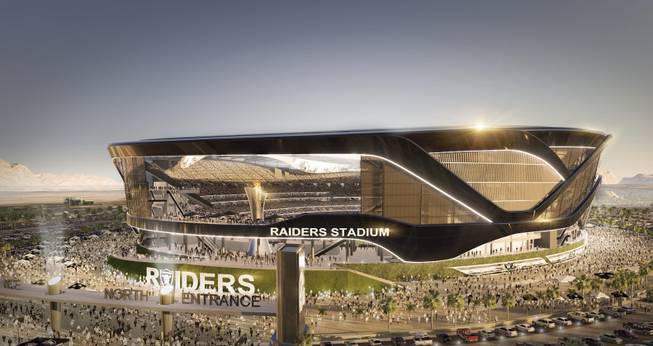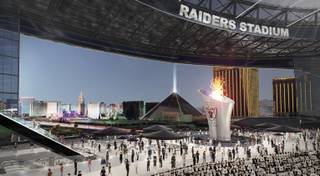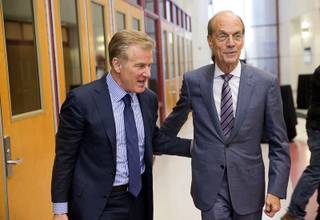
Courtesy of MANICA Architechture
An artist’s illustration of a stadium on Russell Road and Las Vegas Boulevard was revealed during a Southern Nevada Tourism Infrastructure Committee meeting at UNLV Thursday, Aug. 25, 2016.
Published Thursday, Aug. 25, 2016 | 12:30 p.m.
Updated Thursday, Aug. 25, 2016 | 5:50 p.m.
More Coverage
Developers of a proposed NFL stadium in Las Vegas held firm that the public contribution for the project must be $750 million — or no deal.
“We are not negotiable,” Las Vegas Sands President Rob Goldstein said during today’s Southern Nevada Tourism Infrastructure Committee meeting. “The numbers aren’t going down. If we can’t get $750 (million), we respectfully thank you and move on.”
Timing is also of the essence, developers said, because the Oakland Raiders’ owners need to craft their pitch to the NFL to relocate the team to Las Vegas. UNLV football would also play at the stadium. Officials from Sands, Majestic Realty Co. and the Raiders urged the committee, which will issue recommendations to Gov. Brian Sandoval, to expedite the vetting process. Their goal: Assemble a special legislative session before Election Day.
“It’s up to the governor to call a special session, but our preference would be a special session of the Legislature in September,” Andy Abboud, senior vice president of government relations and community development for Sands, said after the meeting.
Regardless of when and if the governor convenes a special session, the wheels are in motion to woo current legislators. Abboud said company officials have been in touch with lawmakers daily, sometimes “two or three” times a day.
They’re keeping legislators abreast of tweaks to the proposal and pursuing their support for the stadium project, which developers have now given a $1.9 billion price tag. Construction costs alone would account for $1.3 billion of that figure.
Before the discussion delved into money, project backers unveiled glitzy renderings of an NFL stadium with a glass-like, see-through roof. The renderings positioned the stadium in two locations — the northwest corner of the Bali Hai golf course and land north of Russell Road and west of Interstate 15.
Stadium proponents said those locations offer the best accessibility and marketability, although other locations haven’t been entirely wiped off the table. The Russell Road acreage, however, seems to have taken the lead, as developers acknowledged that a purchase-and-sale agreement has been signed for that land.
Another win for the Russell Road and Bali Hai sites: Unlike 42 acres of land along Tropicana Avenue, those locations appear to be free from any major airport-related concerns. Rosemary Vassiliadis, director of aviation at McCarran International Airport, said those sites could be workable in terms of FAA height restrictions near the airport.
The Russell Road site is “further away from the center of the runway, and that is a benefit to airport operations as they exist,” she said.
Even so, Las Vegas Mayor Carolyn Goodman renewed her pitch for Cashman Center, one of nine potential stadium sites identified in last month’s committee meeting. Developers have indicated meager support for Cashman, arguing that it’s too far outside the resort corridor.
If a stadium is built in Las Vegas, it will be publicly owned and governed by a stadium authority board, the makeup of which has not been determined.
“The team and the developers will be making a contribution to offset the cost of a public stadium,” Committee Chairman Steve Hill said, hoping to clear up any confusion. “The public is not making a contribution to a privately owned stadium.”
The developers have proposed paying for the $1.9 billion project through $650 million in private funding, $750 million in public funding and $500 million from the football team.
Hill previously introduced a plan that would slash the amount of public funding to $550 million through hotel room taxes. That proposal didn’t sit well with Sands officials, who today reiterated that there’s no wiggle room in the proposed $750 million public contribution.
If that’s the case, Clark County Commissioner Steve Sisolak suggested recommending $550 million to $750 million in public funding — and letting the lawmakers hash it out.
“I think our biggest drawback right now is time,” said Sisolak, who’s a member of the infrastructure committee. “This is going to come down to 63 members of the Legislature voicing their opinion. I don’t know why we don’t go to them sooner rather than later.”
Sands officials said an 0.88 percent increase to the county hotel room tax eventually would pay the public’s portion of the bill. The question is whether lawmakers have an appetite for substantially increasing that tax rate. The infrastructure committee already has recommended a 0.5 percent increase to the hotel room tax to help pay for the Las Vegas Convention Center expansion.
Goldstein said Sheldon Adelson, the billionaire who serves as Sands’ chairman and CEO, is excited and committed to the project, which developers say will inject $335 million into the local economy each year.
The developers have gauged whether other wealthy Las Vegas families would be willing to invest in the project, but to date, no one has coughed up any money — which Goldstein said indicates this is more of a passion project than a money-making endeavor for Adelson. Otherwise, more people would be jumping in to invest, he said.
Goldstein also hinted that the project has attracted the attention of a Major League Soccer franchise, although he declined to name the team.
Raiders President Marc Badain also attended today’s infrastructure meeting and, like the developers, said any decision-making delays could jeopardize the entire project.
Stadium backers want to present a deal to the NFL in January that could trigger the Raiders’ relocation to Las Vegas. Twenty-four of the 32 NFL team owners would need to approve the move, though.
“The sooner we get this done, the faster we can approach the NFL,” he said.
Infrastructure committee members expressed a willingness to move forward as fast as possible. The next meeting is scheduled for Sept. 15, but the committee left open the possibility of holding a meeting sooner.
Last month, Sandoval extended the committee’s deadline until the end of September. If the group recommends legislation to fund and oversee the stadium, the governor likely would need to call a special legislative session.



Join the Discussion:
Check this out for a full explanation of our conversion to the LiveFyre commenting system and instructions on how to sign up for an account.
Full comments policy